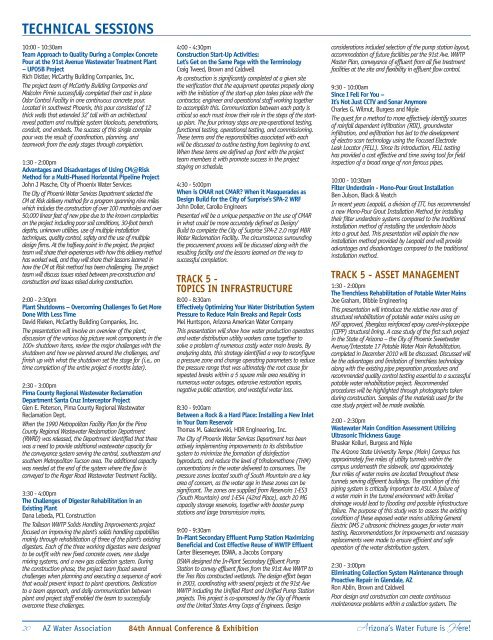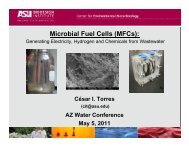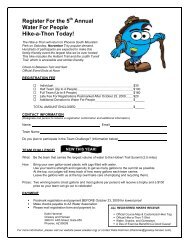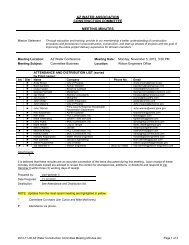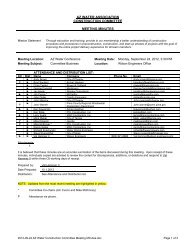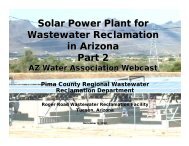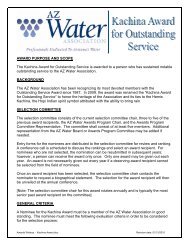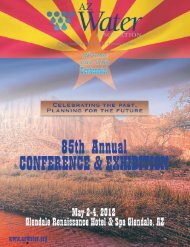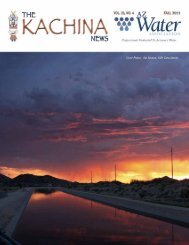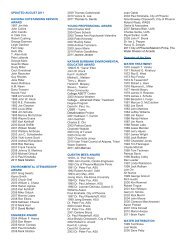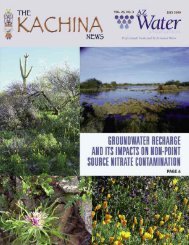Annual Conference Brochure - AZ Water Association
Annual Conference Brochure - AZ Water Association
Annual Conference Brochure - AZ Water Association
Create successful ePaper yourself
Turn your PDF publications into a flip-book with our unique Google optimized e-Paper software.
TECHNICAL SESSIONS<br />
10:00 - 10:30am<br />
Team Approach to Quality During a Complex Concrete<br />
Pour at the 91st Avenue Wastewater Treatment Plant<br />
– UP05B Project<br />
Rich Distler, McCarthy Building Companies, Inc.<br />
The project team of McCarthy Building Companies and<br />
Malcolm Pirnie successfully completed their cast in place<br />
Odor Control Facility in one continuous concrete pour.<br />
Located in southwest Phoenix, this pour consisted of 12<br />
thick walls that extended 32’ tall with an architectural<br />
reveal pattern and multiple system blockouts, penetrations,<br />
conduit, and embeds. The success of this single complex<br />
pour was the result of coordination, planning, and<br />
teamwork from the early stages through completion.<br />
1:30 - 2:00pm<br />
Advantages and Disadvantages of Using CM@Risk<br />
Method for a Multi-Phased Horizontal Pipeline Project<br />
John J Masche, City of Phoenix <strong>Water</strong> Services<br />
The City of Phoenix <strong>Water</strong> Services Department selected the<br />
CM at Risk delivery method for a program spanning nine miles<br />
which includes the construction of over 100 manholes and over<br />
50,000 linear feet of new pipe due to the known complexities<br />
on the project including poor soil conditions, 30-foot trench<br />
depths, unknown utilities, use of multiple installation<br />
techniques, quality control, safety and the use of multiple<br />
design firms. At the halfway point in the project, the project<br />
team will share their experiences with how this delivery method<br />
has worked well, and they will share their lessons learned in<br />
how the CM at Risk method has been challenging. The project<br />
team will discuss issues raised between pre-construction and<br />
construction and issues raised during construction.<br />
2:00 - 2:30pm<br />
Plant Shutdowns – Overcoming Challenges To Get More<br />
Done With Less Time<br />
David Rieken, McCarthy Building Companies, Inc.<br />
The presentation will involve an overview of the plant,<br />
discussion of the various big picture work components in the<br />
100+ shutdown items, review the major challenges with the<br />
shutdown and how we planned around the challenges, and<br />
finish up with what the shutdown set the stage for (i.e., on<br />
time completion of the entire project 6 months later).<br />
2:30 - 3:00pm<br />
Pima County Regional Wastewater Reclamation<br />
Department Santa Cruz Interceptor Project<br />
Glen E. Peterson, Pima County Regional Wastewater<br />
Reclamation Dept.<br />
When the 1990 Metropolitan Facility Plan for the Pima<br />
County Regional Wastewater Reclamation Department<br />
(RWRD) was released, the Department identified that there<br />
was a need to provide additional wastewater capacity for<br />
the conveyance system serving the central, southeastern and<br />
southern Metropolitan Tucson area. The additional capacity<br />
was needed at the end of the system where the flow is<br />
conveyed to the Roger Road Wastewater Treatment Facility.<br />
3:30 - 4:00pm<br />
The Challenges of Digester Rehabilitation in an<br />
Existing Plant<br />
Dana Lebeda, PCL Construction<br />
The Tolleson WWTP Solids Handling Improvements project<br />
focused on improving the plant’s solids handling capabilites<br />
mainly through rehabilitation of three of the plant’s existing<br />
digesters. Each of the three working digesters were designed<br />
to be outfit with new fixed concrete covers, new sludge<br />
mixing systems, and a new gas collection system. During<br />
the construction phase, the project team faced several<br />
challenges when planning and executing a sequence of work<br />
that would prevent impact to plant operations. Dedication<br />
to a team approach, and daily communication between<br />
plant and project staff enabled the team to successfully<br />
overcome these challenges.<br />
20<br />
4:00 - 4:30pm<br />
Construction Start-Up Activities:<br />
Let’s Get on the Same Page with the Terminology<br />
Craig Tweed, Brown and Caldwell<br />
As construction is significantly completed at a given site<br />
the verification that the equipment operates properly along<br />
with the initiation of the start-up plan takes place with the<br />
contractor, engineer and operational staff working together<br />
to accomplish this. Communication between each party is<br />
critical so each must know their role in the steps of the startup<br />
plan. The four primary steps are pre-operational testing,<br />
functional testing, operational testing, and commissioning.<br />
These terms and the responsibilities associated with each<br />
will be discussed to outline testing from beginning to end.<br />
When these terms are defined up front with the project<br />
team members it with promote success in the project<br />
staying on schedule.<br />
4:30 - 5:00pm<br />
When is CMAR not CMAR? When it Masquerades as<br />
Design Build for the City of Surprise’s SPA-2 WRF<br />
John Doller, Carollo Engineers<br />
Presented will be a unique perspective on the use of CMAR<br />
in what could be more accurately defined as Design/<br />
Build to complete the City of Surprise SPA-2 2.0 mgd MBR<br />
<strong>Water</strong> Reclamation Facility. The circumstances surrounding<br />
the procurement process will be discussed along with the<br />
resulting facility and the lessons learned on the way to<br />
successful completion.<br />
TRACK 5 -<br />
TOPICS IN INFRASTRUCTURE<br />
8:00 - 8:30am<br />
Effectively Optimizing Your <strong>Water</strong> Distribution System<br />
Pressure to Reduce Main Breaks and Repair Costs<br />
Mel Huntspon, Arizona American <strong>Water</strong> Company<br />
This presentation will show how water production operators<br />
and water distribution utility workers came together to<br />
solve a problem of numerous costly water main breaks. By<br />
analyzing data, this strategy identified a way to reconfigure<br />
a pressure zone and change operating parameters to reduce<br />
the pressure range that was ultimately the root cause for<br />
repeated breaks within a 5 square mile area resulting in<br />
numerous water outages, extensive restoration repairs,<br />
negative public attention, and wasteful water loss.<br />
8:30 - 9:00am<br />
Between a Rock & a Hard Place: Installing a New Inlet<br />
in Your Dam Reservoir<br />
Thomas M. Galeziewski, HDR Engineering, Inc.<br />
The City of Phoenix <strong>Water</strong> Services Department has been<br />
actively implementing improvements to its distribution<br />
system to minimize the formation of disinfection<br />
byproducts, and reduce the level of trihalomethane (THM)<br />
concentrations in the water delivered to consumers. The<br />
pressure zones located south of South Mountain are a key<br />
area of concern, as the water age in these zones can be<br />
significant. The zones are supplied from Reservoirs 1-ES3<br />
(South Mountain) and 1-ES4 (42nd Place), each 20 MG<br />
capacity storage reservoirs, together with booster pump<br />
stations and large transmission mains.<br />
9:00 - 9:30am<br />
In-Plant Secondary Effluent Pump Station Maximizing<br />
Beneficial and Cost Effective Reuse of WWTP Effluent<br />
Carter Biesemeyer, DSWA, a Jacobs Company<br />
DSWA designed the In-Plant Secondary Effluent Pump<br />
Station to convey effluent flows from the 91st Ave WWTP to<br />
the Tres Rios constructed wetlands. The design effort began<br />
in 2003, coordinating with several projects at the 91st Ave<br />
WWTP including the Unified Plant and Unified Pump Station<br />
projects. This project is co-sponsored by the City of Phoenix<br />
and the United States Army Corps of Engineers. Design<br />
considerations included selection of the pump station layout,<br />
accommodation of future facilities per the 91st Ave. WWTP<br />
Master Plan, conveyance of effluent from all five treatment<br />
facilities at the site and flexibility in effluent flow control.<br />
9:30 - 10:00am<br />
Since I Fell For You –<br />
It’s Not Just CCTV and Sonar Anymore<br />
Charles G. Wilmut, Burgess and Niple<br />
The quest for a method to more effectively identify sources<br />
of rainfall dependent infiltration (RDI), groundwater<br />
infiltration, and exfiltration has led to the development<br />
of electro‐scan technology using the Focused Electrode<br />
Leak Locator (FELL). Since its introduction, FELL testing<br />
has provided a cost effective and time saving tool for field<br />
inspection of a broad range of non‐ferrous pipes.<br />
10:00 - 10:30am<br />
Filter Underdrain - Mono-Pour Grout Installation<br />
Ben Julson, Black & Veatch<br />
In recent years Leopold, a division of ITT, has recommended<br />
a new Mono-Pour Grout Installation Method for installing<br />
their filter underdrain systems compared to the traditional<br />
installation method of installing the underdrain blocks<br />
into a grout bed. This presentation will explain the new<br />
installation method provided by Leopold and will provide<br />
advantages and disadvantages compared to the traditional<br />
installation method.<br />
TRACK 5 - ASSET MANAGEMENT<br />
1:30 - 2:00pm<br />
The Trenchless Rehabilitation of Potable <strong>Water</strong> Mains<br />
Joe Graham, Dibble Engineering<br />
This presentation will introduce the relative new area of<br />
structural rehabilitation of potable water mains using an<br />
NSF approved, fiberglass reinforced epoxy cured-in-place-pipe<br />
(CIPP) structural lining. A case study of the first such project<br />
in the State of Arizona – the City of Phoenix Sweetwater<br />
Avenue/Interstate 17 Potable <strong>Water</strong> Main Rehabilitation,<br />
completed in December 2010 will be discussed. Discussed will<br />
be the advantages and limitation of trenchless technology<br />
along with the existing pipe preparation procedures and<br />
recommended quality control testing essential to a successful<br />
potable water rehabilitation project. Recommended<br />
procedures will be highlighted through photographs taken<br />
during construction. Samples of the materials used for the<br />
case study project will be made available.<br />
2:00 - 2:30pm<br />
Wastewater Main Condition Assessment Utilizing<br />
Ultrasonic Thickness Gauge<br />
Bhaskar Kolluri, Burgess and Niple<br />
The Arizona State University‐Tempe (Main) Campus has<br />
approximately five miles of utility tunnels within the<br />
campus underneath the sidewalk, and approximately<br />
four miles of water mains are located throughout these<br />
tunnels serving different buildings. The condition of this<br />
piping system is critically important to ASU. A failure of<br />
a water main in the tunnel environment with limited<br />
drainage would lead to flooding and possible infrastructure<br />
failure. The purpose of this study was to assess the existing<br />
condition of these exposed water mains utilizing General<br />
Electric DMS 2 ultrasonic thickness gauges for water main<br />
testing. Recommendations for improvements and necessary<br />
replacements were made to ensure efficient and safe<br />
operation of the water distribution system.<br />
2:30 - 3:00pm<br />
Eliminating Collection System Maintenance through<br />
Proactive Repair in Glendale, <strong>AZ</strong><br />
Ron Ablin, Brown and Caldwell<br />
Poor design and construction can create continuous<br />
maintenance problems within a collection system. The<br />
<strong>AZ</strong> <strong>Water</strong> <strong>Association</strong> 84th <strong>Annual</strong> <strong>Conference</strong> & Exhibition Arizona’s <strong>Water</strong> Future is Here!


